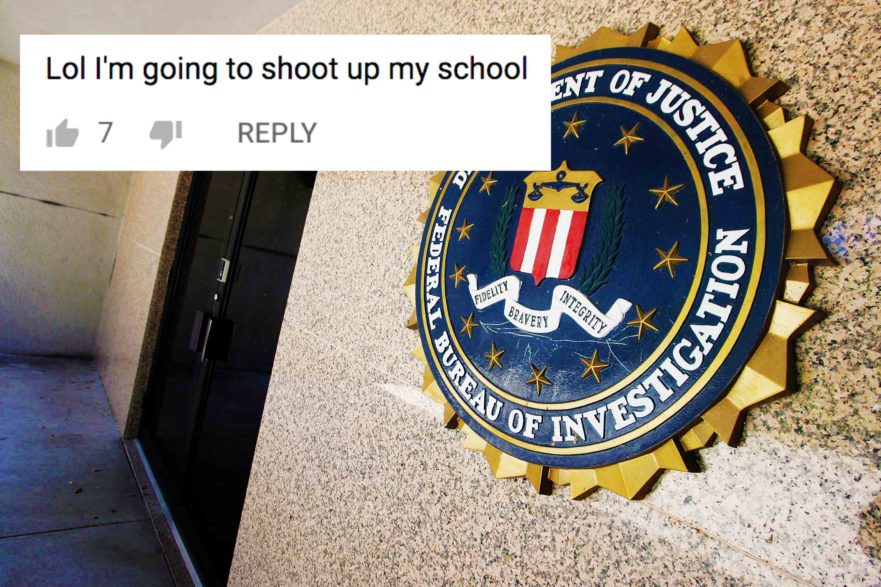FBI building in Miami, Florida. Photo by Joe Raedle/Getty Images.
In July of last year, Brett Boylen found himself in a position familiar to most anyone who has spent interminable hours idling on the internet: He was sucked into a “random YouTube spiral,” unthinkingly gliding from video to algorithmically recommended video while the hours passed by. The algorithm trail eventually led him to a graphic amateur documentary on the 1999 Columbine High School shooting, entitled “COLUMBINE KILLERS – ZERO HOUR.” In the video, which was originally posted in 2013 but seems to have gotten inordinate traffic over the past year, actors portray shooters Dylan Klebold and Eric Harris as they rampage through the school, with real-life interviews and audio recordings from the incident spliced in between. Boylen couldn’t recall how he ended up on that particular video; YouTube viewing sessions are known to take strange turns. But it wasn’t the video that Boylen, a 31-year-old web developer, became startled by.
He scrolled downward. The YouTube comment section is well known as a morass of inflammatory junk even by Internet-commenting standards, but Boylen felt this one warranted his attention.
“Lol I’m going to shoot up my school,” an account by the name of “Satans child” had posted on July 23, 2017. Given that the video under which it appeared pertained to a high-profile school shooting, it wasn’t surprising that some of the dross in the comments would comprise trollish threats from bored adolescents. But “Satans child” went further. In response to a fellow commenter who asked about his or her choice of weaponry, the commenter explained, “I’ll be using a 30/6 and a SKS,” referring to two types of assault rifles. (“Satans child” appears to have changed his or her display name since July, first to “King sDrano,” and then after TYT contacted the user through the YouTube messaging system, to “Drano.” The original inflammatory YouTube comments were deleted after TYT’s queries.)
Boylen felt that notwithstanding the inherently impertinent nature of YouTube commenting, this level of specificity was cause for concern. So he took screenshots, and called his local FBI field office in Charlotte, N.C. “It was a really quick conversation,” he recalled. “It seemed like they were in a hurry to get off the phone.” Boylen said he gave the name of the video to the FBI representative he spoke with, who looked it up for herself while they were on the phone. But beyond that, so far as he could tell, nothing more came of it. He never heard back.
Seven months later, after Nikolas Cruz killed 17 people at Parkland High School, Boylen’s mind was brought back to the episode. Cruz was reported to have left an eerily similar comment under a YouTube video just months before the shooting—“Im going to be a professional school shooter,” Cruz allegedly wrote in September 2017—which was spotted by a YouTube user and reported to the FBI. In that case, the FBI immediately contacted the man who flagged the comment, Ben Bennight, and dispatched agents to meet with him the following day. Though the comment Bennight saw under one of the videos he published on his channel was written by someone named “nikolas cruz,” the FBI hasn’t confirmed that it was the same person who committed the mass shooting. “The FBI conducted database reviews, checks, but was unable to further identify the person who made the comment,” special agent Robert Lasky later said.
In fact, the comment Boylen saw may have been more actionable than the one attributed to Cruz, as it referenced specific types of weaponry. But Boylen was never contacted, and had no idea if the threat was ever investigated. So two days after the Parkland shooting, he called the FBI back, again at his local field office. “Nobody ever followed up with me, or asked me any questions, or anything,” he told the FBI representative on the phone, according to a recording of the call reviewed by TYT. “I’m concerned that something’s gone unnoticed.”
Ostensibly, the FBI staffer he was talking to sympathized. “You just want to make sure that your tip was actually filed, and that it didn’t fall into a dark hole,” the representative replied. “I completely understand that.”
“We’ll make sure that the tip that you filed . . . I’ll make sure that they are documented.”
But several weeks later, there’s still been no follow-up with Boylen. Boylen has no idea whether his tip was actually registered or recorded. (A tip about Cruz’s threatening behavior a month before the shooting was not properly routed after being received at the FBI’s call center.) The offending YouTube comments Boylen saw were still posted on the video page as of March 9, though buried under an avalanche of additional, unrelated comments; after TYT sent questions to the user through YouTube’s messaging system, they disappeared. The FBI did not respond to a list of questions emailed them by TYT. (Boylen says he also reported the comments to YouTube, which did not reply to a request for comment from TYT.)
Boylen acknowledges that part of his motivation for worrying about the comments in the first place could have been slight paranoia. “But what are you supposed to do?” he asked. “There is no other way to go about it. It has to be some type of law enforcement, even if it was a 13-year-old making idle threats.” With the massive volume of idle threats proliferating on the Internet, it’s near impossible for the average YouTube viewer to discern which threatening comment should be taken seriously and which should be discounted as juvenile saber-rattling.
Until the FBI, YouTube, and average Internet users have a better grasp of how to contextualize these kinds of comments, confusion and more paranoia will likely reign.
Michael Tracey is a staff reporter for TYT Investigates.
Follow TYT Investigates on Twitter, Facebook, and YouTube to stay on top of exclusive news stories from The Young Turks.

